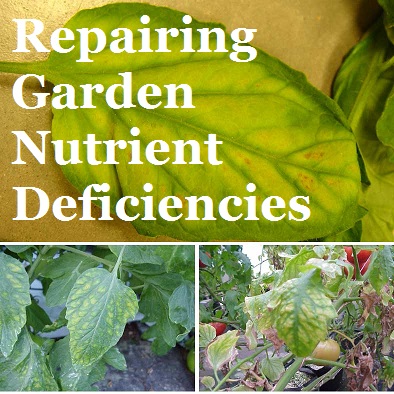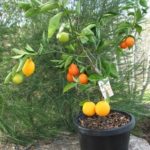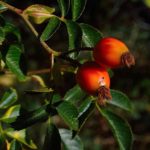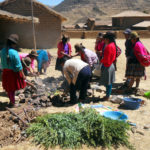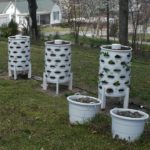Some posts may contain affiliate links.
Repairing Garden Nutrient Deficiencies
If plants fail to do well, despite adequate soil preparation, watering and mulching, it may be a sign of a nutrient deficiency. Fruit and vegetables, plants grown in containers, and ones growing in very acid or alkaline soils are all vulnerable. Yellow or reddish colored leaves, stunted growth and poor flowering are all common symptoms of nitrogen, magnesium or potassium deficiency.
NITROGEN DEFICIENCY
You will notice spindly yellow plants or yellow leaves, sometimes with pink tints. Nitrogen promotes green, leafy growth and deficiency results in yellowing and stunted growth. Nitrogen is very soluble, and is easily washed out of the soil in winter rains. leaving the soil deficient in spring. Nitrogen deficiency is a common cause of yellow leaves in spring.
TO FIX: In the long term, mulching with organic matter (such as well rotted garden compost or manure) provides a steady trickle of nitrogen to stabilize levels. In the short term, applying high nitrogen fertilizers such as sulfate of ammonia or poultry manure pellets will fix the problem.
POTASSIUM DEFICIENCY
You will notice yellow or purple leaf-tints with browning at the leaf edge and poor flowering or fruiting. Potassium is needed for controlling both water uptake and the process allowing plants to harness energy from the sun (photosynthesis). Potassium promotes flowering, fruiting and general hardiness. Shortages are more likely on light, sandy or chalky soils where potassium is easily washed away.
TO FIX: Apply high potassium fertilizers such as sulfate of potash, tomato feed or an organic potassium source derived from sugar beet processing.
PHOSPHORUS DEFICIENCY
You will notice slow growth and dull yellow foliage. Phosphorus is needed for healthy roots and shoot growth. Soil shortages of phosphorus are rare, but may occur in areas with high rainfall and heavy clay soil.
TO FIX: Apply fertilizers such as super phosphate or bone meal.
MAGNESIUM DEFICIENCY
You will notice yellowing between the leaf veins, sometimes with reddish brown tints and early leaf fall. Magnesium deficiency is common in tomatoes, apples, grape vines, raspberries, roses and rhododendrons. Magnesium is needed for healthy leaves and for plants to harness energy from the sun (photosynthesis). Soil shortages of magnesium are more common on light, sandy soils. Over-use of high-potassium fertilizers (such as tomato feed) can cause magnesium deficiency, as plants take up potassium in preference to magnesium.
TO FIX: In the short term, apply Epsom salts as a foliar feed in summer. Dilute the salts at a rate of 20g of Epsom salts per liter of water (1/3 oz per pint) plus a few drops of liquid detergent. Apply once a week, spraying in dull weather to avoid leaf scorch. In the long term, apply to the soil around the roots either Dolomite limestone (calcium-magnesium carbonate) at 4 oz per sq yd or Epsom salts (magnesium sulfate) at 1 oz per sq yd.
MANGANESE + IRON DEFICIENCIES
You will notice yellowing between the leaf veins with browning of leaf edges on acid-loving plants. Manganese and iron are important for allowing plants to harness the energy of the sun (photosynthesis). Soil shortages are rare, but manganese and iron can be unavailable to plant roots in alkaline conditions.
TO FIX: Apply chelated iron and manganese treatments, such as Sequestrene, to the soil around the plant roots.
BORON DEFICIENCY
You will notice stunted growth and tip die back on lettuce, brown cracks in celery; rotten swedes, turnips and celeriac. Boron is required for healthy plant cell formation. Soil shortages are rare, but this nutrient can be less available to plant roots in alkaline conditions.
TO FIX: Treat by applying borax (disodium tetraborate) to the soil before sowing vegetables. Soil application rates for borax are: 1 oz per 20 sq yd. Mix well with a large quantity of light sand before spreading so that the chemical is evenly distributed.
For all your plant needs you can find them at Danny’s site The Seed Guy
Source: Danny Look
 This is an aggregated site. Please be aware some of the sites we link to could have pop ups. We have no control over them. However, we will never link you to a site that requires you to make any purchase to view the blog.
This is an aggregated site. Please be aware some of the sites we link to could have pop ups. We have no control over them. However, we will never link you to a site that requires you to make any purchase to view the blog.
Please read our disclaimer. We provide you with information from various sites all over the world. The author’s expressed opinion isn’t necessarily that of The Prepared Page or its staff. Our intent is to bring you the information. Use your and your own best judgment when using any information contained within the blogs.
While you’re here check out some of the other posts you may find them interesting!!!
Some posts may contain affiliate links.

